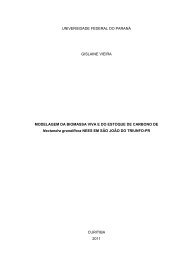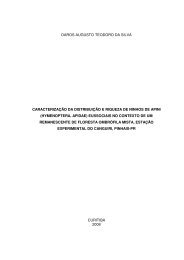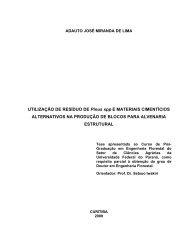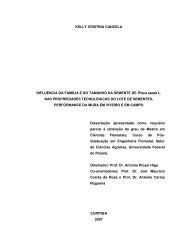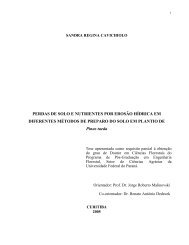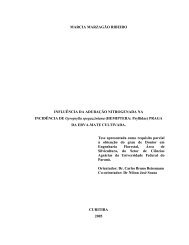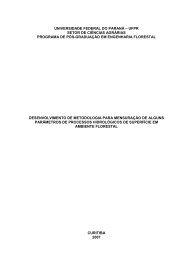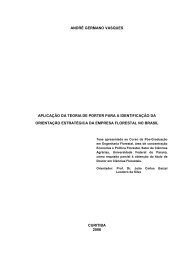Dissertação em PDF - departamento de engenharia florestal - ufpr ...
Dissertação em PDF - departamento de engenharia florestal - ufpr ...
Dissertação em PDF - departamento de engenharia florestal - ufpr ...
You also want an ePaper? Increase the reach of your titles
YUMPU automatically turns print PDFs into web optimized ePapers that Google loves.
ABSTRACT<br />
Jatropha curcas is a forest specie that belongs to Euphorbiaceae family and is popularly<br />
known as physic nut. Despite having high potential for biodiesel production, there is little<br />
information and studies about the type, including the potential for vegetative propagation. To<br />
this end, the aim of the study were the establishment in vitro un<strong>de</strong>r aseptic conditions of<br />
different explants (epicotyls, hypocotyls, rootlets and cotyledons) of Jatropha curcas in<br />
culture medium for multiplication from seeds of five provenances germinated in vitro. At the<br />
first experiment, the seeds were germinated in culture medium Murashige and Skoog (MS)<br />
with half strength of nutrients and without addition of sucrose, which were evaluated<br />
disinfestation and germination of seeds from each origin. This experiment was conducted in<br />
completely randomized <strong>de</strong>sign. After germination, the parts of each seedling were<br />
transferred to complete culture medium Murashige and Skoog (MS) with different sources<br />
and concentrations of growth regulators (benzylaminopurine, kinetin, thidiazuron, a<strong>de</strong>nine<br />
sulfate and indol butiric acid), interconnected, being this the second experiment, where were<br />
evaluated contamination and oxidation of explants as well as qualitative and quantitative<br />
parameters, such as bud and callus induction, color of buds and callus, callus texture, size<br />
and number of buds and fresh and dry weight. This experiment was conducted in completely<br />
randomized <strong>de</strong>sign with factorial arrang<strong>em</strong>ent. In the first experiment, the disinfection was<br />
effective in only two of the five origins that were studied, and the contamination was mainly<br />
by fungi and bacteria also, with a percentage of the origins of contamination ranging from 0<br />
to 85%; germination happens in two of five origins, and the percentages of germination<br />
ranged from 0 to 99,17%. In the second experiment, could be verified that both oxidation and<br />
contamination of the explants happened in the seventh day of cultivation, with statistical<br />
difference between the origins, combinations of growth regulators and explant sources for<br />
both evaluations. The percentage of explants that induced buds and callus varied<br />
significantly for origins, combinations of growth regulators and sources of explants. The color<br />
of buds ranged from green to yellow, the color of callus ranged from cream, green and<br />
brown, and the texture of callus ranged from compact and friable, all statistically different for<br />
origins, combinations of growth regulators and sources of explant. As to quantitative<br />
analysis, the number of buds that showed the best results, in general, happened for the<br />
origin Santa Vitoria – MG, to the combination of growth regulators composed by MS medium<br />
with addition of 27.8 µM of BAP and 0.5 µMof IBA, and for cotyledonary explants, with an<br />
average of formation of shoots per explant of 5.02, 10.92 and 7, respectively. As for the size<br />
of the shoots, this ranged from small seedlings (less than 0.1 cm), medium (between 0.1 and<br />
1 cm) and large (greater than 1 cm), in which the majority of the shoots had small size. For<br />
the variables fresh weight and dry weight, there was statistical difference for origins,<br />
combinations of growth regulators and sources of explant, being the results, in general,<br />
presented for the origin Janaúba – MG, for the combination of growth regulators compound<br />
by MS medium suppl<strong>em</strong>ented with 27.8 µM of BAP and 0.5 µM of IBA, and for hypocotyls<br />
explants type.<br />
Keywords: Jatropha curcas; micropropagation; tissue culture.<br />
v



